by Susan Dean | Feb 2, 2018 | Food and Health Dangers, Gardening, Health

Genetically Modified Organisms
The United States government has allowed genetically modified and engineered organisms to enter the public food supply with no warning. Every day, millions of people unknowingly ingest these GMOs because corporations like Monsanto (and the politicians they’ve bought and paid for) claim it’s unfair to require them to label their products.
Multiple scientific studies have linked GMOs to illness, disease, and mutations in plants, animals, and humans. Adverse affects are especially pronounced in pregnant women and children. The low price, processed foods carry most of the world’s GMOs. The only way to protect yourself from these toxic “foods” is to avoid buying and eating them.
These are the foods that are worth the extra time it may take to research origins and the extra money it may cost to buy organic. Buying local is ideal, because you can contact the farmer directly to ask what kinds of seeds are used.
- Tomatoeswere the first genetically modified crop to be commercially available in the U.S. In 1994, transgenic tomatoes known as FlavrSavrshit the market. They contained a “deactivated” gene that was supposed to prevent the fruit from getting soft as it ripened. It didn’t work as well as biotech companies hoped. Now, experts are praising a new technique whereby two enzymes, (A-Man, B-hex) are suppressed. There have been reports that some animals have died shortly after consuming GMO tomatoes.
- CornThis one is tough, because even foods that you wouldn’t normally associate with corn have ingredients, like sweeteners, that are derived from GMO corn. As Care2′s Jaelithe Judy reports, genetically modified cornand soybeans were developed by Monsanto in the 1990s to be resistant to the synthetic herbicide glyphosate (better known by Monsanto’s trademarked name for the weedkiller, Roundup). Now, more than 70 percent of corn produced in the United States is the genetically modified, herbicide-resistant variety. Fresh corn from Walmart should be especially avoided.
- PapayasIn the late 1980′s biotech researchers developed a papaya cultivar that would be resistant to Papaya Ringspot Virus. To do this, certain viral genes encoding capsid proteins were transferred to the papaya genome. Now, GMO papayas make up about 75 percent of the total Hawaiian papaya crop.
- Riceis considered to be one of the world’s staple crops. In many areas, it has been genetically modified to contain a high amount of vitamin A. More recently, it was discovered that an American company, Ventria Bioscience, has been cultivating rice that’s genetically modified (GM) with genes from the human liver. Although the company claims it’s only producing this rice to help speed pharmacuetical research, it’s growing it in open, outdoor fields. Meaning crops nearby can be unknowingly contaminated. China, which grows and consumes a huge percentage of the global rice supply, recently suspended distribution of genetically modified rice within its commercial food supplies over growing concern about its safety.
- Potatoeswere once one of the world’s most important staple crops, but thanks to growing awareness about the harm of too many empty carbohydrates, demand for potatoes as food has waned slightly in the past few years. Desperate for a way to infuse potatoes with more nutrients, researchers in India created a potato with thirty-five to sixty percent more protein using genes from the amaranth seeds. The potato is still very valuable to the starch and chemical industry, however. In order to protect these starch crops from pets and disease, potatoes are sometimes genetically modifiedwith Bacillus thuringiensis var. Kurstaki Cry 1. Yet, mice fed GE potatoes have shown abnormal amounts of toxins in their systems. According to Dr. Nina V. Fedoroff Willaman, Professor of Life Sciences and Evan Pugh Professor at Pennsylvania State University found that “rats fed the transgenic potatoes had significantly lower organ weights.”
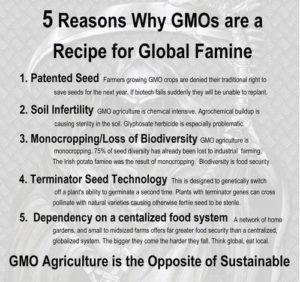
Research links Monsanto’s GMO corn to cancer, tumors and an increase risk of premature death in both men and women. News of the research is spreading like wildfire across the ‘net, and support for Proposition 37 — which seeks to label GMOs in foods — is growing by the day.
According to the Center for Food Safety, up to 85% of the corn grown in the United States is genetically modified. This means corn-based cereals that use non-organic corn have a very high likelihood of containing GM corn.
The following list presents the top 10 popular breakfast cereals most likely to contain Monsanto’s genetically modified corn. The exact GMO content of these cereals remains a mystery precisely because manufacturers of these cereals refuse to label them with their GMO content.
Legal note: This article is presented in the public interest, reflecting reasonable caution over a common food ingredient which French scientists have now convincingly linked to cancer and premature death in studies conducted on rats.
The top 10 popular breakfast cereals most likely to contain Monsanto’s GM corn
http://www.naturalnews.com/037315_Monsanto_GM_corn_breakfast_cereals.html#ixzz2Og4iFL7N
Which cereals contain no GMOs? Nature’s Path
There is only one brand of breakfast cereal I know of that’s 100% non-GMO and 100% organic across their entire product line. That company is Nature’s Path:
Many “natural” brands that appear to be healthful and natural are actually not organic or GMO-free. For example, “Barbara’s Bakery” cereals are not organic. Although they are positioned in store shelves alongside other organic cereals, they are actually made with conventional crops grown with pesticides that may include Monsanto’s Roundup.
You may notice that most of the cereal likely to contain GM corn are children’s cereals. It is the children in America who are being fed the most GMOs. This represents a highly unethical food experiment being conducted on an entire generation, and the long-term effects of human consumption of GMOs are simply not known. What we do know is that rats fed this very same Monsanto GM corn developed shockingly large cancer tumors.
The photo released by the French research team, showing large cancer tumors growing at a strongly heightened risk in rats fed a “lifetime” of Monsanto’s GM corn, is shown below. According to that study, 70% of females died premature and showed significant damage to their liver, kidneys and other organs.
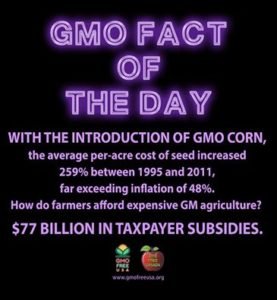
Top 10 Worst GMO Foods
1. Corn: As many as half of all U.S. farms growing corn for Monsanto are using genetically modified corn,” and much of it is intended for human consumption. Monsanto’s GMO corn has been tied to health issues that include weight gain and organ disruption.
2. Soy: Found in tofu, vegetarian products, soybean oil, soy flour, and numerous other products, soy is modified to resist herbicides. As of now Monsanto still has a tight grasp on the soybean market, with approximately 90 percent of soy being genetically engineered to resist Monsanto’s herbicide Roundup. In one single year, 96.7 million pounds of glyphosate was sprayed on soybeans alone
3. Sugar: According to NaturalNews, genetically modified sugar beets were introduced to the U.S. market in 2009. Like others, they’ve been modified by Monsanto to resist herbicides.
4. Aspartame: Aspartame is a toxic additive used in numerous food products, and should be avoided for numerous reasons, including the fact that it is created with genetically modified bacteria.
5. Papayas: GMO papayas have been grown in Hawaii for consumption since 1999. Though they can’t be sold to countries in the European Union, they are welcome with open arms in the U.S. and Canada.
6. Canola: One of the most chemically altered foods in the U.S. diet, canola oil is obtained from rapeseed through a series of chemical actions.
7. Cotton: Found in cotton oil, cotton originating in India and China in particular has serious risks.
8. Dairy: Your dairy products contain growth hormones, with as many as one-fifth of all dairy cows in America are pumped with these hormones. In fact, Monasnto’s health-hazardous rBGH has been banned in 27 countries, but is still in most US cows. If you must drink milk, buy organic.
9. and 10. Zucchini and Yellow Squash: Closely related, these two squash varieties are modified to resist viruses.
The dangers of some of these foods are well known. The Bt toxin being used in GMO corn was recently detected in the blood of pregnant women and their babies. All the risks that are still unknown.
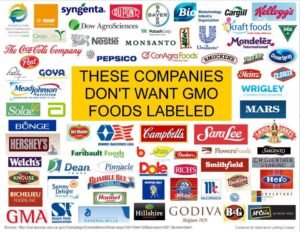
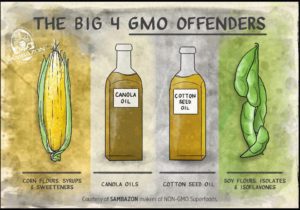
by Susan Dean | Feb 2, 2018 | Food and Health Dangers, Health, Kitchen Recipes, Medicinal Recipes

Sugar cravings and eating too many foods that contain sugar may cause health problems such as diabetes, obesity, and heart disease. The sugary foods that you eat will cause blood sugar to increase quickly and then crash. The blood sugar crash then makes you crave more sugar, so you eat more sugary foods and the cycle continues. According to Dr. Deirdre Rawlings of the Clayton College of Natural Health, one can break this unhealthy cycle by eating healthy foods that fight sugar cravings.
To combat sugar cravings, Dr. Rawlings recommends that people eat these top 5 healthy foods.Apple
Fruits taste naturally sweet, making them effective in fighting sugar cravings. One of the best fruits that helps fight sugar cravings is the apple. Apples taste very sweet and they are high in fiber. Fiber makes the stomach feel full and helps satisfy sugar cravings. Apples are easy to carry and they don’t need to be peeled or cut like other fruits. Apples take longer to chew, so the person eating it will soon start thinking that he is no longer hungry, thus reducing his sugar cravings.Sweet corn
Sweet corn is a healthy food that can help fight sugar cravings. Sweet corn is different from ordinary field corn because of its mutation at the sugary locus. Sweet corn is great for fighting sugar cravings because it tastes sweet when cooked and one will feel quite full after eating an ear of it. It is rich in antioxidants, vitamins, minerals, and dietary fiber.Sweet potato
Another vegetable that tastes sweet when cooked is the sweet potato. Sweet potatoes can be chopped up and then fried to make sweet potato fries. Sweet potatoes will not only satisfy sugar cravings, but supply the body with vitamin C, vitamin D, vitamin B6, and iron. The nutrients in sweet potatoes can help prevent heart disease, cancer, and other degenerative diseases.
Cinnamon
The extraordinary properties of cinnamon can help fight sugar cravings. The main active ingredient of cinnamon is hydroxychalcone, which helps enhance the effects of insulin and satisfies your sugar cravings. Cinnamon prevents the blood sugar spikes that cause sugar cravings and normalizes blood sugar levels.
Tomatoes
Tomatoes can also fight sugar cravings because they are high in serotonin. Studies suggest that low serotonin levels are among the main causes of sugar cravings. The serotonin in tomatoes functions as a neurotransmitter that tells a person’s brain that his sugar cravings have been satisfied. Tomatoes are high in chromium, a mineral that reduces food cravings, regulates cholesterol, fat and blood sugar levels.
The foods in this list will fight sugar cravings and improve the body’s overall health. Dr. Rawlings recommends that these foods be included in one’s daily diet so that one will be able to keep sugar cravings at bay
Get Rid of Sugar in Your Diet – Sugar is addictive. It is in almost everything in a grocery from vitamins to cereals, canned goods, sauces, pickles, jams and jellies, breads, and numerous drinks. Not to mention the candy and cake and cookies! For you to eat 1 teaspoon of refined sugar, you would have to eat 8 pounds of sugar beets! Nobody does that. It’s not normal. Too much sugar throws you off balance, can cause heart disease, diabetes, and give you the sugar blues! Use natural sugars like honey, molasses, or dark maple syrup occasionally but cut sugar out of your diet as much as possible.
Follow these simple steps to get rid of the sugar:
Eat quality meat and eggs from pastured or grass fed animals at each meal to control blood sugar.
Eat wild fish 3 times a week for omega-3′s.
Eat good fat at every meal from coconut oil, grass fed butter, ghee, red palm oil, olive oil for balanced hormones.
Drink 64 oz of pure water daily for proper cellular function.
Eat 4 cups of colorful vegetables daily to Detox.
Clean out your cupboards of tempting snacks and treats.
Don’t buy sugar filled products.
Associate with people who do not eat sugar for support.
Do some exercise like walking, circuit training, sprinting, intervals 3 days a week.
Practice deep breathing and slow stretching everyday.
Find your burning reason to do this and keep it posted on the fridge.
Get 8 hours of sleep from 10:30 pm to 6:30 am every night.
Work with a qualified health care practitioner to help choose sugar detox supplements.

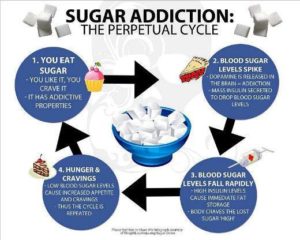


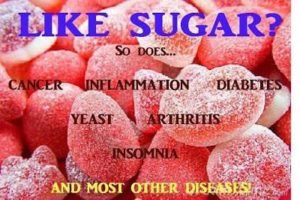

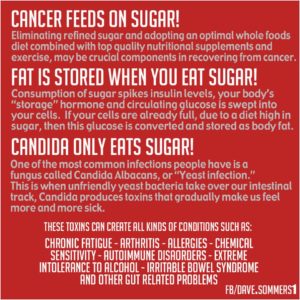

by Susan Dean | Feb 2, 2018 | Food and Health Dangers, Health
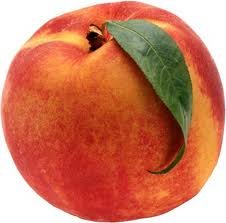
This is the latest research on pesticides and insecticides in our food. Buy organic or better yet – Grow your own.
Fruits and Pesticides
Apples – Cancer causers, hormone disruptors and neurotoxins have all been detected on apples, 98 percent of which test positive for pesticides. Because they’re so popular and are eaten daily by so many people, apples earned the top spot on EWG’s list of foods you should always buy organic.
Blueberries – More than 40 different pesticides were found on blueberries grown in the U.S.
Cherries – One of the most commonly used pesticides on cherries, carbaryl, is suspected of causing cancer and may lead to neurological diseases such as Parkinson’s and to birth defects.
Nectarines – The USDA found the average imported nectarine contained more pesticides by weight than any other food. Domestically grown nectarines didn’t fare much better. They contained the same range of pesticides, but at lower levels.
Peaches – Many of the pesticides used on peaches are systemic. They’re sprayed on a tree before it bears fruit, but the chemicals wind up getting into the fruit as it grows, and there’s no way to remove them.
Pears – 92 percent of pear samples tested positive for at least one pesticide residue, while 26 percent were tainted with 5 or more pesticides.
Imported Plums – The most common pesticide found on plums imported from abroad (mostly Chile) is iprodione, which the Environmental Protection Agency has dubbed a “likely” carcinogen.
Strawberries A single sample of strawberries tested by the USDA contained 13 different pesticides.
Grapes – More pesticides are used on grapes than on any other fruit. Combined, the various samples of grapes used in the 2012 EWG report contained 64 different pesticides.
5 Pesticide Foods to Avoid and Why:
1. Peaches. Farmed peaches are number one because so many pesticides are needed to grow them. Their skin absorbs much of it infecting the flesh with carcinogenic chemicals that outweigh the peach’s natural health benefits.
2. Apples. Many apples are grown in mid-western states where they are not native and haven’t developed natural defenses to predators. They are treated with many harmful pesticides that seep into the peel. You can peel your apples but lose a third of the nutrients and some flavor.
3. Sweet Bell Peppers. This vegetable has the highest likelihood of containing multiple pesticides (64 found on a single sample)
4. Celery. This vegetable has no skin and the pesticides are absorbed directly into the plant. It’s best to buy this fresh and organic.
5. Strawberries. Their skin doesn’t absorb as much as a peach but they are small and we don’t often wash them carefully. The Organic Trade Association stated that more than 371 pesticides are approved for use on U.S. strawberries and because they grow close to the ground, they are subject to chemicals used on soils.
The Dirty Dozen
When it comes to these items, try to buy these in organic form to avoid the excessive amounts of pesticide.
1. Strawberries
2. Celery
3. Apples
4. Peaches
5. Spinach
6. Nectarines
7. Kale/collard greens
8. Sweet bell peppers
9. Lettuce
10. Blueberries
11. Potatoes
12. Grapes
The Clean 15
These 15 produce items are known by the EWG as the “clean 15″. They have the least amount of pesticides and would be considered the items to buy if you can’t afford to go completely organic.
1. Grapefruit
2. Sweet corn (This is generally GMO, so you may want to always stick to organic with corn)
3. Pineapples
4. Avocado
5. Mushrooms
6. Cantaloupe
7. Sweet potatoes
8. Eggplant
9. Sweet peas
10. Kiwi
11. Cabbage
12. Watermelon
13. Mangoes
14. Onions
15. Asparagus
Based on an analysis conducted over a period of time between 2001 – 2009 by the USDA and FDA, 53 popular produce items were tested creating a series of 51,000 tests. The produce items were rinsed and peeled to recreate the general conditions in which they are consumed. The conclusion of the analysis confirmed that if someone were to eat from the clean 15 and purchased organically from the dirty dozen, they would lower their pesticide intake by 92%.
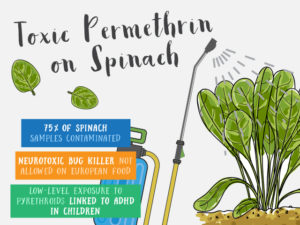

by Susan Dean | Feb 2, 2018 | Food and Health Dangers, Health

#1: Food Allergies. Researchers from Albert Einstein College of Medicine at Montefiore Medical Center in New York City found an association between food allergies and the levels of a pesticide breakdown product in urine. People with high levels of dichlorophenol, a breakdown product of the herbicide 2,4-D and of chlorine used to disinfect tap water, were more likely to suffer allergies to milk, eggs, seafood, and peanuts. Dichlorophenol acts like an antimicrobial and could interfere with healthy bacterial levels in the gut, which, in turn, could upset the body’s natural immune reactions to certain allergens in food.
#2: Memory Loss. Another review from University College London recently concluded that low levels of pesticides, such as those considered safe for farm workers who are exposed on a daily basis, cause significant damage to cognitive function—your memory, the speed at which you process information, and your ability to plan for the long term. The review used data from 14 different studies and looked at organophosphate pesticides, which are some of the most harmful chemicals used in agriculture.
#3: Diabetes. Scientists have been noticing a link between pesticides and diabetes for years. The latest evidence comes out of the Endocrine Society’s 94th Annual Meeting, where Robert Sargis, MD, PhD, released the results of a study that suggest tolyfluanid, a fungicide used on farm crops, creates insulin resistance in fat cells. A 2011 study published in Diabetes Care found that overweight people with higher levels of organochlorine pesticides in their bodies faced a higher risk of developing type 2 diabetes.
#4: Cancer. More than 260 studies link pesticides to various cancers, including lymphoma, leukemia, soft tissue sarcoma, and brain, breast, prostate, bone, bladder, thyroid, colon, liver, and lung cancers, among others. The President’s Cancer Panel suggests eating organic and avoiding plastic to lower your risk of environmentally triggered cancers.
#5: Autism & Other Developmental Diseases. How do you get autism? The world’s leading autism researchers believe the condition develops from a mix of genes and the pollutants encountered in the mother’s womb and early in life. Many insecticides effectively kill bugs by throwing off normal neurological functioning. That same thing appears to be happening in some children. A 2010 Harvard study found that children with organophosphate pesticide breakdown materials in their urine were far more likely to live with ADHD than kids without the trace pesticide residues.
#6: Obesity. Some agrochemical pesticides act as hormone disruptors, meaning they act like a fake version of a naturally occurring hormone in your body, they block important hormone communication pathways in the body, or they interfere with your body’s ability to regulate the healthy release of hormones. More than 50 pesticides are classified as hormone disruptors, and some of them promote metabolic syndrome and obesity as they accumulate in your cells, according to 2012 study appearing in Environmental Health Perspectives.Food isn’t the only place where these obesogenic chemicals could be lurking. Avoid canned foods and other foods packaged in plastic. Studies have shown that chemicals, such as BPA and phthalates, in food packaging could play a role in obesity as well.
#7: Parkinson’s Disease. More than 60 studies show a connection between pesticides and the neurological disease Parkinson’s, a condition characterized by uncontrolled trembling. The association is strongest for weed- and bug-killing chemical exposures over a long period of time, meaning it’s important to keep these toxic compounds out of your household routine. Uuse natural pest control measures.
#8: Infertility. Pesticides spell trouble in the baby-making department, thanks to their bad habit of not staying put. Atrazine, a common chemical weed killer used heavily in the Midwest, on Southern sugar cane farms, and on golf courses, has been detected in tap water. Doctors and scientists point to published evidence tying atrazine to increased miscarriage and infertility rates. Other pesticides cause a plunge in male testosterone levels. A 2006 study found chlorpyrifos, a chemical used in nonorganic apple and sweet pepper farming, and carbaryl, a go-to pesticide in strawberry fields and peach orchards, caused abnormally low testosterone levels.
#9: Birth Defects. Babies conceived during the spring and summer months—a time of year when pesticide use is in full swing—face the highest risk of birth defects. During these months, higher pesticide levels turn up in surface waters, increasing a mother’s risk of exposure. Spina bifida, cleft lip, clubfoot, and Down syndrome rates are higher when moms become pregnant during high season for pesticides.
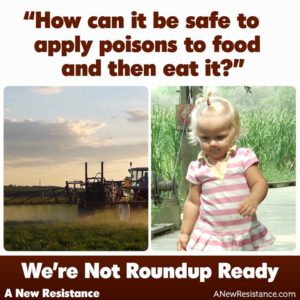
WEED KILLER? USE VINEGAR NOT ROUNDUP
Spray plants with inexpensive white vinegar. Use vinegar on gravel paths and brick walk-ways. It is a proven effective, eco-friendly answer to Roundup. Monsanto agreed with the New York Attorney General’s office to discontinue the use of the terms “biodegradable” and “environmentally friendly” in ads promoting Roundup. These terms were lies. Roundup is not biodegradable nor environmentally friendly. Vinegar is cheap and easy to use. How to Apply: use a watering can, a spray bottle or a pump-sprayer to apply vinegar. Rinse sprayer after use, or metal part can corrode. Make your application on a warm, sunny, calm day. Use vinegar on walkways where grass and ornamental plants are not an issue. It keeps pathways free of unwanted growth. You can also use plain salt water.
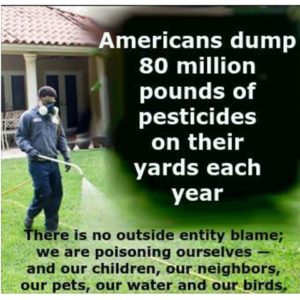
by Susan Dean | Feb 2, 2018 | Food and Health Dangers, Health
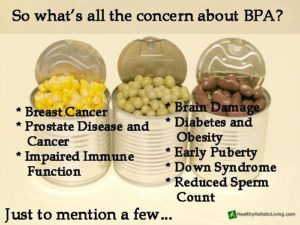
The Serious Dangers of BPA The canned-food chemical bisphenol A, or BPA, has been under attack for years, with studies suggesting it’s associated with negative health impacts ranging from cancer and obesity to infertility and heart disease.
BPA is a common hormone-disrupting chemical used as a liner in metal food and drink cans and in cash-register receipts.
A new study published in the Proceedings of the National Academy of Sciences is strengthening the push to ban BPA, showing that levels found in most Americans is increasing breast cancer risk in monkeys, a close relative of humans.
“These findings strongly suggests that BPA is a breast carcinogen in humans, and human exposure to BPA should be curtailed,” says study coauthor Ana M. Soto, MD, professor of anatomy and cell biology at Tufts University School of Medicine in Boston.
A pregnant monkeys’ low-level exposure caused abnormal changes in the offspring’s breast tissue. The offspring’s mammary glands were denser, one of the leading risk factors in breast cancer.
BPA is chemically related to diethylstilbestrol, an estrogen that increases the risk of breast cancer in both rodents and in women exposed in the womb. BPA is an estrogen, and estrogens are considered carcinogens.
Research on BPA and breast cancer risk involves fetal exposure and cancer that develops decades later. A study published in the journal Circulation showed a direct link between high BPA exposure in healthy adults and greater risk of developing heart disease. BPA overrides the female body’s natural heartbeat signaling causing arrhythmia (erratic beating that could cause sudden cardiac death) in heart tissue testing.
No matter what your age, and regardless of your desire to become pregnant, it’s in everyone’s best interest to reduce BPA exposure.
The Food and Drug Administration was sued and forced to consider a BPA ban in food packaging, but said earlier this year it needed more time to determine whether the chemical threatens human health.
A few companies say they are planning to move away from use of BPA in canned goods, including Campbell’s Soup. Some canned food companies, like Eden Foods, have already removed BPA from cans and named the replacement. Campbell’s, however, isn’t naming the replacement chemical or saying when the BPA ban will go into effect. Some researchers fear BPA replacement chemicals could be just as bad—or worse—than BPA.
Avoiding canned food and drinks is a great way to reduce BPA exposure, but because the chemical is produced in heavy volumes and used in so many products, many public health experts believe government needs to intervene to cut back on this toxic exposure.
If we try to decrease our exposure to BPA by reducing the use of plastics and canned food, and avoiding to touch credit card receipts, there’s no way of knowing if we’ve reduced exposure by 5 percent or 95 percent; thus, what we need is regulatory action to decrease human exposure to BPA.
by Susan Dean | Feb 2, 2018 | Food and Health Dangers, Health
Monosodium Glutamate (MSG)
Commonly found in Chinese food, MSG is used as a flavor enhancer in soups, salad dressings, chips and frozen foods. In people sensitive to the compound, MSG can overexcite cells, producing uncomfortable symptoms. Research shows a correlation between overconsumption of foods containing MSG and medical conditions such as depression, disorientation, eye damage, fatigue, headaches, and obesity.
Artificial Sweeteners (Aspartame/Saccharine/Mannitol) are packed with chemicals that can be harmful to your body. Most of these sweeteners contain the Aspartame. Studies have suggested Aspartame is linked to a wide spectrum of health problems like brain tumors, diabetes, lymphoma, multiple sclerosis, Parkinson’s, Alzheimer’s, fibromyalgia, chronic fatigue, and emotional disorders like depression and anxiety. It has also been linked to symptoms including dizziness, headaches, nausea, mental confusion, seizures, and affects short-term memory and intelligence.
BHA And BHT may prevent your food from changing color, losing flavor, or becoming rancid, but it has been suggested they can increase chances of getting cancer. However, FDA states that BHA and BHT are safe to consume, and another study published by the NCBI (National Center for Biotechnology Information) compared them with Vitamin E. Not certain? You’ll find them in everything from gum to cereals — just check the label and opt out.
Trans fat found in many processed foods can be one of the most dangerous substances to consume. It occurs naturally in some animal products, and is synthetically created by adding hydrogen to vegetable oils. Used to extend the shelf life of many food products, the consumption of trans fats, according to the FDA, raises LDL (bad cholesterol). Elevated levels of LDL increase the risk of high blood pressure, potentially resulting in heart attack, stroke, diabetes and heart disease.
Sodium Nitrate (naturally occurring compound) and Sodium nitrite (synthetically created compound) are both commonly used to preserve meat products in place of salt. Both are nitrosamines, which studies have shown when consumed in large amounts over time damage DNA, potentially resulting in cancers, and the development of pulmonary diseases.
Artificial Food Coloring can have a very negative effect on your health. FDA studies exploring the effect of dyes on children’s behavior were inconclusive, prompting more studies to be undertaken. Some studies have suggested food dye may cause thyroid cancer, kidney and adrenal tumors, and chromosome deterioration.
Sodium Sulfite is frequently used during wine production and can be found in dried fruit. It can cause dangerous reactions in people sensitive or allergic to it. One study found it induced cell degranulation and oxidant stress. It has been linked to asthma, rashes, headaches, and breathing problems.
Sulfur Dioxide is a toxic additive, commonly found in beer, dried fruits such as apricots, chips and soft drinks. While no definitive study has linked it to negative health effects it is feared in foods because as a gas, inhaling too much can cause conjunctivitis, bronchitis, emphysema, bronchial asthma, and potentially cardiovascular disease.
High-Fructose Corn Syrup is found in almost all processed foods. It has become the number one source of calories in America. Beware! High-fructose corn syrup, which provides zero nutritional benefit, is found in the healthy foods we eat as well. Be sure to check the labels of yogurts, cereals, and granola bars for this harmful additive.
Potassium Bromate is used to increase the volume of bread products, this additive has been proven to cause cancer in animals. It is banned as an additive in the EU, Canada and Brazil, but not in the United States. California is the only state that requires labels for products with potassium Bromate.





















